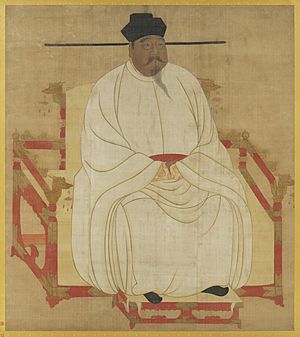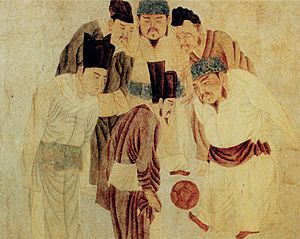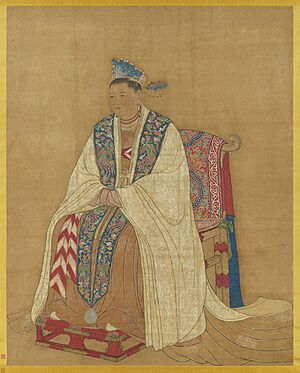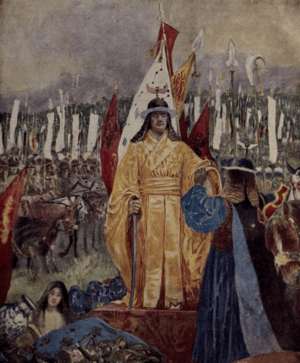Emperor Taizu of Song facts for kids
Quick facts for kids Emperor Taizu of Song宋太祖 |
|||||||||||||
|---|---|---|---|---|---|---|---|---|---|---|---|---|---|

|
|||||||||||||
| Emperor of the Song dynasty | |||||||||||||
| Reign | 4 February 960 – 14 November 976 | ||||||||||||
| Coronation | February 960 | ||||||||||||
| Successor | Emperor Taizong | ||||||||||||
| Born | Zhao Kuangyin 21 March 927 Luoyang, Later Tang dynasty |
||||||||||||
| Died | 14 November 976 (aged 49) Bianjing, Northern Song dynasty |
||||||||||||
| Burial | Yongchang Mausoleum (永昌陵, in present-day Gongyi, Henan) | ||||||||||||
| Consorts | Empress Xiaohui (m. 944; died 958) Empress Xiaoming (m. 958; died 964) Empress Xiaozhang (m. 968–976) |
||||||||||||
| Issue | Zhao Dezhao Zhao Defang Princess Xiansu Princess Xianjing Princess Xianhui |
||||||||||||
|
|||||||||||||
| House | Zhao | ||||||||||||
| Dynasty | Song (Northern Song) | ||||||||||||
| Father | Zhao Hongyin | ||||||||||||
| Mother | Empress Dowager Zhaoxian | ||||||||||||
| Signature |  |
||||||||||||
| Emperor Taizu of Song | |||||||||||||||||||||||
|---|---|---|---|---|---|---|---|---|---|---|---|---|---|---|---|---|---|---|---|---|---|---|---|
| Chinese | 宋太祖 | ||||||||||||||||||||||
| Literal meaning | "Great Progenitor of the Song" | ||||||||||||||||||||||
|
|||||||||||||||||||||||
| Zhao Kuangyin | |||||||||||||||||||||||
| Traditional Chinese | 趙匡胤 | ||||||||||||||||||||||
| Simplified Chinese | 赵匡胤 | ||||||||||||||||||||||
|
|||||||||||||||||||||||
Emperor Taizu of Song (born Zhao Kuangyin on March 21, 927 – died November 14, 976) was the first emperor of China's Song dynasty. He ruled from 960 until his death in 976. Before becoming emperor, he was a skilled military general for the Later Zhou dynasty. Emperor Taizu became ruler after a coup d'état (a sudden takeover of power). He made the last Later Zhou ruler, Emperor Gong, give up his throne.
During his time as emperor, Taizu conquered several smaller states. These included Southern Tang, Later Shu, Southern Han, and Jingnan. This helped him bring most of China proper back together under one rule. To make his power stronger, he reduced the influence of military generals. Instead, he relied on civilian officials to help him govern. His younger brother, Zhao Kuangyi, became emperor after him.
Contents
Early Life and Military Skills
Zhao Kuangyin was born in Luoyang. His father, Zhao Hongyin, was a military commander. Zhao Kuangyin was very good at mounted archery (shooting arrows while riding a horse). Once, he rode a wild horse without a bridle. He hit his head on a city gate and fell off. But he quickly got back up and chased the horse. He managed to control it without getting hurt. In the mid-940s, he married Lady He. This marriage was arranged by his father. After traveling for a few years, he joined the army in 949. He served under Guo Wei, a military governor called a jiedushi. Zhao Kuangyin helped Guo Wei stop a rebellion.
Rising Through the Ranks
In 951, Guo Wei started his own rebellion. He then created the Later Zhou dynasty. Zhao Kuangyin was promoted to a palace guard commander. This was because of his amazing fighting skills. Chai Rong, the emperor, noticed Zhao Kuangyin's potential. He made Zhao Kuangyin a commander of the cavalry (horseback soldiers). Under Chai Rong, Zhao Kuangyin's journey to power truly began.
The Battle of Gaoping
Zhao Kuangyin's career took off at the Battle of Gaoping. This battle was against an alliance of the Northern Han and Liao dynasties. The fight began when Chai Rong became emperor. Liu Chong decided to work with the Liao dynasty. At first, the Later Zhou army's right side was defeated. Zhao Kuangyin and Zhang Yongde then led 4,000 elite palace troops. They went to fight the Liao army. Zhao Kuangyin encouraged his soldiers to be loyal to the emperor. This quickly boosted their spirits. His small force held off the larger Liao army until more troops arrived. In the end, their successful counter-attack pushed the Northern Han back to Taiyuan.
This victory helped Zhao Kuangyin become the grand commander of the palace guards. He also reorganized and trained them. More importantly, he built strong relationships with other generals and officials. Within a few years, Zhao Kuangyin had full control of the palace guards. He even created a group of trusted officials under him.
Soon, he was promoted to a jiedushi (military governor). This gave him most of the military power under Chai Rong. However, he still had two rivals. One was Zhang Yongde, Guo Wei's son-in-law. The other was Li Chongjin, Guo Wei's nephew. In 959, Zhao Kuangyin set a trap for Zhang Yongde. This led to Zhang Yongde being demoted. After Chai Rong died, his seven-year-old son, Guo Zongxun, became emperor. Li Chongjin soon lost his political support. Zhao Kuangyin used his influence to move Li Chongjin to another area as a jiedushi.
The Chenqiao Mutiny
In 960, the chancellor (a high government official) Fan Zhi heard a rumor. He heard that the Northern Han and Liao dynasties were planning to invade again. Without checking if the rumor was true, Fan Zhi sent Zhao Kuangyin to fight them. After traveling about 40 li (a Chinese unit of distance), a strange story spread. People claimed a "prophet" saw two suns fighting. This was said to mean that the "Mandate of Heaven" (the right to rule) would pass to Zhao Kuangyin. This story quickly spread among the army. Soldiers became unhappy with the young emperor's command. Their loyalty shifted to Zhao Kuangyin.
A few days later, Zhao Kuangyin was asleep in his tent. His troops had stayed awake all night. They grabbed their weapons and started shouting. Zhao Pu and Zhang Kuangyi, who were guarding the tent, saw what was happening. They went into the tent to wake up Zhao Kuangyin. When he came out, all the troops yelled, "The army has no master! We want to make the general our new emperor!" It is said that Zhao Kuangyin took power unwillingly. He only did so because his soldiers urged him. The mutiny happened at midnight. Officers forced Zhao Kuangyin to take the throne. But when they presented him to the troops as their new commander-in-chief, he refused. He only accepted after they swore to obey him completely.
News of the rebellion quickly reached the capital city. Chaos broke out. Only one person, Han Tong, thought about resisting. But one of Zhao Kuangyin's generals killed him when he got home.
When Zhao Kuangyin entered the capital to become emperor, he gave an important order. He told his troops not to loot the city. He also told them not to harm the people.
This takeover allowed Zhao Kuangyin to become emperor in 960. The city gates were opened for him. He became emperor without any resistance. Before the chancellor Fan Zhi could speak, one of Zhao Kuangyin's generals pointed a sword at him. He said, "We have no master. Today, we must have an emperor." The officials looked at each other. They knew it was useless to resist. They all bowed down. With the court under his control, Zhao Kuangyin was officially declared emperor. The new dynasty was named Song. This name came from the Song Prefecture, where Zhao Kuangyin's army was based.
After becoming emperor, Zhao Kuangyin sent the young dethroned emperor, Guo Zongxun, and his mother to the Western Capital. He personally ordered his own family, the Zhao family, to care for the Chai family for generations.
Emperor Taizu's Reign

In 960, Zhao Kuangyin helped reunite most of China proper. China had been broken up and rebellious since the fall of the Tang dynasty in 907. The plan during Chai Rong's rule was to conquer the north first, then the south. But Emperor Taizu changed this strategy. He decided to conquer all the smaller southern states first. These included Later Shu, Southern Han, and Southern Tang. The only exception was the strong Northern Han state in the north. It was supported by the Khitans of the Liao dynasty. Emperor Taizu's plan was to win over the independent southern states. This was because the south was weaker than the north, which had Liao dynasty support.
In 968, Emperor Taizu personally led his army against the Northern Han. At first, his forces broke through their defenses. They surrounded Taiyuan. But he was forced to retreat after attacking the Northern Han defenses. This happened when Liao cavalry came to help.
Emperor Taizu set up the main rules and policies for future Song emperors. He is remembered for making the imperial examination system much bigger. This meant that most government officials were chosen through these exams. This was different from the Tang dynasty, where less than 10% of officials came from exams. He also created schools that allowed a lot of freedom for discussion and new ideas. This helped lead to many scientific advances, economic changes, and achievements in arts and literature.
Emperor Taizu is also famous for bringing the military under control. He ended the time of warlords (powerful local military leaders). He made the central government stronger than regional commanders. This stopped anyone else from gaining power the way he did. After becoming emperor, he invited his top generals to a grand dinner. There, he convinced them all to retire as military leaders. Or, they could accept smaller jobs. In return, he offered them large estates and generous retirement money.
During the feast, the new emperor gave a speech. He thanked all the military officers for helping him become emperor. He said he wanted to reward them as much as possible. Then he explained that he couldn't feel safe on his new throne if they still commanded their armies. He said that if they thought about it, they wouldn't feel safe either. He promised that they and their families would live happily if they accepted his offer to retire with benefits. None of the generals refused his terms. This started a time of peace within the Song dynasty. It also made the military forces stronger for dealing with rival empires around them.
Many historical records from the Song dynasty and later tell the story of "Taizu's Oath." This oath supposedly forbade his successors from killing scholar-officials. However, this story might have been made up later.
Death and Succession

Emperor Taizu ruled for seventeen years. He died in 976 at the age of 49. It is interesting that his younger brother, Zhao Kuangyi, became emperor after him. This happened even though Taizu had two grown sons. These were Zhao Dezhao, the Prince of Yan, and Zhao Defang, the Prince of Qin. Traditional historical accounts say that Zhao Kuangyin's mother played a big role in this decision. This decision was made shortly after the Song dynasty began, around 961. So, for almost his entire rule, it was known that Zhao Kuangyi would be his successor.
In popular stories, there is a tale called "shadows by the candle and sounds from an axe." This story suggests that Emperor Taizu was murdered by his brother, who wanted the throne. After his death, Taizu was buried at the Yongchang Mausoleum, near Gongyi.
After Emperor Taizong, the next emperors were his sons and their descendants. They were not from Emperor Taizu's direct line. However, Emperor Gaozong (who ruled from 1127–1161) had no heir. So, in 1161, he chose a descendant of Emperor Taizu to be his adopted heir. After 1161, all later Song emperors were descendants of Emperor Taizu through his two sons, Zhao Dezhao and Zhao Defang.
Family Life

Zhao Kuangyin's family came from humble beginnings. Their history cannot be traced back with certainty beyond the Later Tang period. His great-great-grandfather, Zhao Tiao, was an official in Zhuozhou, Hebei Province. His descendants, Zhao Ting and Zhao Jing, also served as local officials in Hebei. Zhao Jing's son, Zhao Hongyin (Emperor Taizu's father), chose a military career instead of a civil one. He served under Zhuangzong of Later Tang. He knew that during times of disunity, a military career would lead to success.
Consorts and Children
- Empress Xiaohui, from the He clan (929–958)
- Zhao Dexiu, Prince Teng (first son)
- Zhao Dezhao, Prince Yanyi (951–979), second son
- Zhao Delin, Prince Shu (third son)
- Princess Xiansu (died 1008), first daughter
- Married Wang Chengyan in 970
- Princess Xianjing (died 1009), second daughter
- Married Shi Baoji in 972
- Empress Xiaoming, from the Wang clan (942–964)
- Zhao Defang, Prince Qinkanghui (959–981), fourth son
- Two unnamed daughters
- Empress Xiaozhang, from the Song clan (952–995)
- Unknown mothers
- Princess Xianhui (died 999)
- Married Wei Xianxin in 972
- Princess Anhui
- Princess Xianhui
- Princess Xuanhui
- Princess Xianhui (died 999)
See also
- Architecture of the Song dynasty
- Chinese emperors family tree (middle)
- Culture of the Song dynasty
- Economy of the Song dynasty
- History of the Song dynasty
- List of emperors of the Song dynasty
- List of unsolved deaths
- Society of the Song dynasty
- Technology of the Song dynasty



